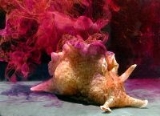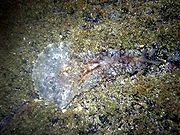
Sea hare
Encyclopedia
The clade
Aplysiomorpha, commonly known as Sea hares or Sea Bags (Aplysia
species and related genera), are medium-sized to very large Opisthobranchia
with a soft internal shell made of protein. These are marine
gastropod molluscs in the superfamilies Aplysioidea and Akeroidea.
The common name
"sea hare" derives from their rounded shape and from the two long rhinophores that project upwards from their heads and that somewhat resemble the ears of a hare
.
They are also referred to locally in their natural coastal habitat of Southern California as the "Sea Bag" This is due to their appearance resembling a tan grocery shopping bag floating in the water upon initial glance.
established the taxon Anaspidea as a suborder.
. Anaspidea has been replaced in the new Taxonomy of the Gastropoda (Bouchet & Rocroi, 2005)
by the clade
Aplysiomorpha.
The scientific name for the order in which they used to be classified, the Anaspidea, is derived from the Greek
for "without a shield" and refers to the lack of the characteristic head shield found in the cephalaspidean opisthobranchs. Many anaspideans have only a thin, internal and much-reduced shell with a small mantle
cavity; some have no shell at all. All species have a radula
and gizzard plates.
, can reach a length of 75 centimetres (29.5 in) and a weight of 2 kilograms (4.4 lb) and is arguably the largest gastropod species.
Sea hares have soft bodies with an internal shell, and like all opistobranch mollusks they are hermaphroditic
. Unlike many other gastropods, they are more or less bilaterally symmetrical in their external appearance. The foot has lateral projections, or "parapodia".
 Sea hares are herbivorous, and are typically found on seaweed
Sea hares are herbivorous, and are typically found on seaweed
in shallow water. It seems to be the case that some young sea hares are capable of burrowing in soft sediment leaving only their rhinophores and mantle opening showing. Sea hares have an extremely good sense of smell. They can follow even the faintest scent using their rhinophores, which are extremely sensitive chemoreceptors.
Their color corresponds with the color of the seaweed they eat: red sea hares have been feeding on red seaweed. This camouflage
s them from predators. When disturbed, a sea hare can release ink from its ink glands, providing a potent deterrent to predators. This release acts as a smoke screen, while at the same time, adversely affecting the smell sensors of their predators. In a small environment, this ink could be toxic to the inhabitants. The color of the ink is white, purple or reddish, depending on the color of the pigments in their seaweed food source. Their skin contains a similar toxin that renders sea hares largely inedible to many predators.
Some sea hares can employ jet propulsion
as a locomotory method, although without the sophisticated cognitive machinery of the cephalopod
s their motion is somewhat erratic.
Clade
A clade is a group consisting of a species and all its descendants. In the terms of biological systematics, a clade is a single "branch" on the "tree of life". The idea that such a "natural group" of organisms should be grouped together and given a taxonomic name is central to biological...
Aplysiomorpha, commonly known as Sea hares or Sea Bags (Aplysia
Aplysia
Aplysia is a genus of medium-sized to extremely large sea slugs, specifically sea hares, which are one clade of large sea slugs, marine gastropod mollusks. The general description of sea hares can be found in the article on the superfamily Aplysioidea....
species and related genera), are medium-sized to very large Opisthobranchia
Opisthobranchia
Opisthobranchs are a large and diverse group of specialized complex marine gastropods previously united under Opisthobranchia within the Heterobranchia, but no longer considered to represent a monophyletic grouping...
with a soft internal shell made of protein. These are marine
Marine (ocean)
Marine is an umbrella term. As an adjective it is usually applicable to things relating to the sea or ocean, such as marine biology, marine ecology and marine geology...
gastropod molluscs in the superfamilies Aplysioidea and Akeroidea.
The common name
Common name
A common name of a taxon or organism is a name in general use within a community; it is often contrasted with the scientific name for the same organism...
"sea hare" derives from their rounded shape and from the two long rhinophores that project upwards from their heads and that somewhat resemble the ears of a hare
Hare
Hares and jackrabbits are leporids belonging to the genus Lepus. Hares less than one year old are called leverets. Four species commonly known as types of hare are classified outside of Lepus: the hispid hare , and three species known as red rock hares .Hares are very fast-moving...
.
They are also referred to locally in their natural coastal habitat of Southern California as the "Sea Bag" This is due to their appearance resembling a tan grocery shopping bag floating in the water upon initial glance.
Taxonomy
Many older textbooks and websites refer to this suborder as Anaspidea. The original author P. Fischer described the taxon Anaspidea at unspecified rank above family. In 1925 Johannes ThieleJohannes Thiele
Johannes Thiele, full name Karl Hermann Johannes Thiele was a German zoologist specialized in malacology. His Handbuch der systematischen Weichtierkunde is a standard work...
established the taxon Anaspidea as a suborder.
2005 taxonomy
However, since the taxon Anaspidea was not based on an existing genus, this name is no longer available according to the rules of the ICZNInternational Code of Zoological Nomenclature
The International Code of Zoological Nomenclature is a widely accepted convention in zoology that rules the formal scientific naming of organisms treated as animals...
. Anaspidea has been replaced in the new Taxonomy of the Gastropoda (Bouchet & Rocroi, 2005)
Taxonomy of the Gastropoda (Bouchet & Rocroi, 2005)
The taxonomy of the Gastropoda as it was revised by Philippe Bouchet and Jean-Pierre Rocroi is currently the most up-to-date overall system for classifying gastropod mollusks...
by the clade
Clade
A clade is a group consisting of a species and all its descendants. In the terms of biological systematics, a clade is a single "branch" on the "tree of life". The idea that such a "natural group" of organisms should be grouped together and given a taxonomic name is central to biological...
Aplysiomorpha.
The scientific name for the order in which they used to be classified, the Anaspidea, is derived from the Greek
Greek language
Greek is an independent branch of the Indo-European family of languages. Native to the southern Balkans, it has the longest documented history of any Indo-European language, spanning 34 centuries of written records. Its writing system has been the Greek alphabet for the majority of its history;...
for "without a shield" and refers to the lack of the characteristic head shield found in the cephalaspidean opisthobranchs. Many anaspideans have only a thin, internal and much-reduced shell with a small mantle
Mantle (mollusc)
The mantle is a significant part of the anatomy of molluscs: it is the dorsal body wall which covers the visceral mass and usually protrudes in the form of flaps well beyond the visceral mass itself.In many, but by no means all, species of molluscs, the epidermis of the mantle secretes...
cavity; some have no shell at all. All species have a radula
Radula
The radula is an anatomical structure that is used by molluscs for feeding, sometimes compared rather inaccurately to a tongue. It is a minutely toothed, chitinous ribbon, which is typically used for scraping or cutting food before the food enters the esophagus...
and gizzard plates.
2010 taxonomy
Jörger et al. (2010) have moved this taxon (named as Anaspidea) to Euopisthobranchia.Description
Sea hares are mostly rather large, bulky creatures. The biggest species, Aplysia vaccariaAplysia vaccaria
Aplysia vaccaria, also known as the "black sea hare," and the "California black sea hare," is a species of extremely large sea slug, a marine, opisthobranch, gastropod mollusk in the family Aplysiidae. It is the largest known species of sea slug, and may be the world's largest living gastropod. -...
, can reach a length of 75 centimetres (29.5 in) and a weight of 2 kilograms (4.4 lb) and is arguably the largest gastropod species.
Sea hares have soft bodies with an internal shell, and like all opistobranch mollusks they are hermaphroditic
Hermaphrodite
In biology, a hermaphrodite is an organism that has reproductive organs normally associated with both male and female sexes.Many taxonomic groups of animals do not have separate sexes. In these groups, hermaphroditism is a normal condition, enabling a form of sexual reproduction in which both...
. Unlike many other gastropods, they are more or less bilaterally symmetrical in their external appearance. The foot has lateral projections, or "parapodia".
Life habits

Seaweed
Seaweed is a loose, colloquial term encompassing macroscopic, multicellular, benthic marine algae. The term includes some members of the red, brown and green algae...
in shallow water. It seems to be the case that some young sea hares are capable of burrowing in soft sediment leaving only their rhinophores and mantle opening showing. Sea hares have an extremely good sense of smell. They can follow even the faintest scent using their rhinophores, which are extremely sensitive chemoreceptors.
Their color corresponds with the color of the seaweed they eat: red sea hares have been feeding on red seaweed. This camouflage
Camouflage
Camouflage is a method of concealment that allows an otherwise visible animal, military vehicle, or other object to remain unnoticed, by blending with its environment. Examples include a leopard's spotted coat, the battledress of a modern soldier and a leaf-mimic butterfly...
s them from predators. When disturbed, a sea hare can release ink from its ink glands, providing a potent deterrent to predators. This release acts as a smoke screen, while at the same time, adversely affecting the smell sensors of their predators. In a small environment, this ink could be toxic to the inhabitants. The color of the ink is white, purple or reddish, depending on the color of the pigments in their seaweed food source. Their skin contains a similar toxin that renders sea hares largely inedible to many predators.
Some sea hares can employ jet propulsion
Jet propulsion
Jet propulsion is motion produced by passing a jet of fluid in the opposite direction to the direction of motion. By conservation of momentum, the moving body is propelled in the opposite direction to the jet....
as a locomotory method, although without the sophisticated cognitive machinery of the cephalopod
Cephalopod
A cephalopod is any member of the molluscan class Cephalopoda . These exclusively marine animals are characterized by bilateral body symmetry, a prominent head, and a set of arms or tentacles modified from the primitive molluscan foot...
s their motion is somewhat erratic.
Human use
Aplysia californica is a typical example of a sea hare, and is noteworthy for its usefulness in studies of neurobiology because of the unusually large size of the axons that are a part of its nerve cells.External links
- California Brown Sea Hare — Cabrillo Marine AquariumCabrillo Marine AquariumCabrillo Marine Aquarium is an aquarium in San Pedro, California, United States, a community within Los Angeles. It concentrates on the marine life of Southern California...
- Aplysiidae (sea slugs) of Hawaii

